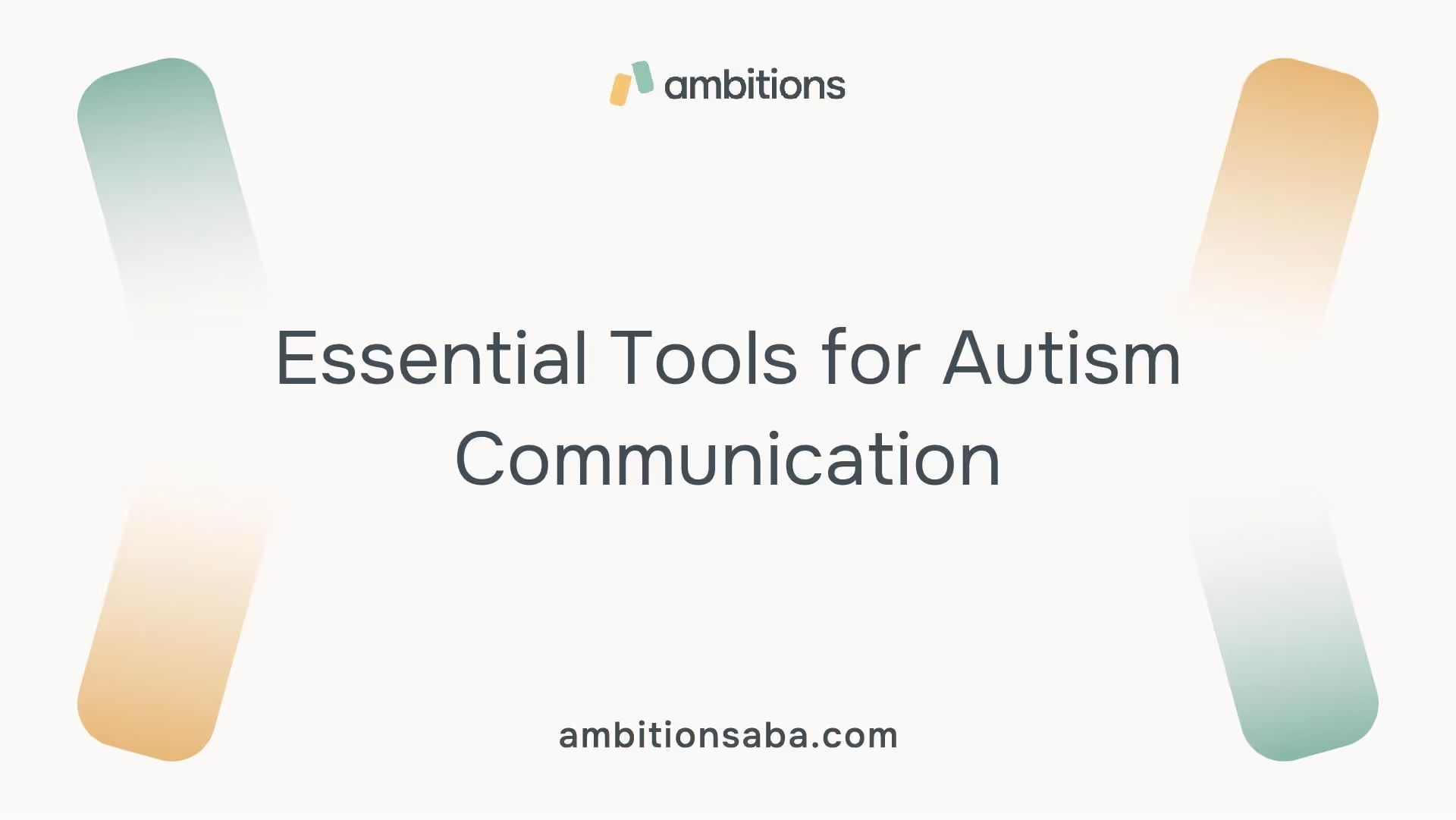Enhancing Communication for Autism
Effective communication is a critical component for individuals with autism spectrum disorder (ASD). Various tools and technologies can significantly enhance communication abilities, providing essential support for fostering independence and improving social interactions.

Augmentative and Alternative Communication (AAC)
Augmentative and alternative communication (AAC) is a specific type of assistive technology that benefits individuals with autism of all ages, regardless of their speech abilities. AAC systems are designed to promote independence, expand communication, and increase opportunities for social interactions. These systems can be divided into two main categories: unaided and aided forms.
Here’s a quick comparison of AAC types:
TypeDescriptionExamplesUnaidedNo external tools neededGestures, sign languageAidedRequires external toolsCommunication boards, SGDs
Importance of Technology
Technology plays an essential role in supporting individuals with autism. Communication challenges can include difficulties in holding conversations, understanding facial expressions, and inferring communicative intent based on context. Such challenges, along with sensory overloads—such as discomfort during eye contact—may hinder effective interaction [2].
Assistive technology can bridge these communication gaps, offering customized solutions that cater to individual needs. For many, technology has not only enhanced communication but has also expanded their potential in various settings, including educational and workplace environments.
As individuals navigate their communication journeys, leveraging available tools can result in significant advancements in their overall quality of life. For project ideas related to sensory experiences, visit our article on creating sensory spaces for autism.
Accessible communication systems empower individuals with ASD, making their voices heard and promoting a more inclusive world.
Success Stories with Assistive Tech

Technology can significantly enhance communication and independence for individuals diagnosed with autism. This section highlights how devices like iPads and iPhones have made a positive impact on their lives.
iPad for Independence
Many individuals have reported that using an iPad has increased their independence. For instance, Jennifer, a young woman with autism, utilizes her iPad as a tool for communication and organization. She uses various applications designed specifically for people with autism, allowing her to express her needs and engage with others more effectively [3].
The flexibility of the iPad provides users access to augmentative and alternative communication (AAC) strategies that promote autonomy. These applications can include visual schedules, social stories, and speech-generating devices. As a result, individuals can navigate daily activities and communicate their thoughts and feelings more efficiently.
Benefits of iPad for IndependenceDescriptionEnhanced CommunicationAccess to AAC applications for expressing needsOrganizationTools for managing schedules and tasksSocial InteractionPlatforms for engaging with peers and family
Impact of iPhones
iPhones have also made a remarkable difference in promoting self-sufficiency among individuals with autism. One parent shared their experience of how using an iPhone taught their son essential life skills, such as managing his schedule and making calls when necessary [3].
With various user-friendly applications available, iPhones facilitate communication while catering to the specific needs of users. Features like voice commands, text-to-speech, and accessible interfaces contribute to making tasks manageable for those with autism.
Impact of iPhonesDescriptionLife Skills DevelopmentEncourages responsibility through task managementCommunicationAllows for easier connection with friends and familyAccessibilityVoice commands and other features enhance usability
These tools show the power of technology to change lives and support individuals with autism in becoming more independent. The stories of those using iPads and iPhones illustrate just one aspect of how these tools for autism communication help enhance daily experiences. For more on creating supportive environments, consider exploring creating sensory spaces for autism and positive behavior tips for autism.
Tools for Autism Communication
Using the right tools for autism communication can make a significant difference in the lives of those on the autism spectrum. Two popular methods are the Picture Exchange Communication System (PECS) and voice output devices. Both options provide unique benefits to individuals diagnosed with autism.
Picture Exchange Communication System (PECS)
The Picture Exchange Communication System (PECS) is widely recognized as an effective communication tool for children with developmental disabilities, particularly those with autism. Individual users carry a hardcover book filled with a variety of icons. These icons can be handed to someone or lined up on a plastic strip to express needs or requests.
Using PECS encourages not only communication but also the development of social skills. As individuals learn to utilize this system, they engage more with their environment, allowing for a sense of autonomy and expression.
Here is a table summarizing the key features of PECS:
FeatureDescriptionVisual IconsUtilizes a set of images to represent various needs and requests.Gradual Learning ProcessMoves from simple exchanges to more complex sentence structures.Reinforces Social InteractionEncourages engagement and negotiation skills.
By employing this system, individuals can effectively communicate their desires, leading to improved interactions and satisfaction.
Voice Output Devices
Voice output devices are another effective assistive technology option that provides those with autism a way to communicate verbally, despite their challenges with spoken language. These devices can come in many forms, ranging from simple speech-generating devices (SGDs) to more complex tablets equipped with specialized communication apps.
The primary advantage of voice output devices is that they can articulate phrases and sentences automatically, allowing for seamless communication. They have adjustable settings that cater to different levels of need and can often be customized with personalized messages. Voice output devices enhance independence, as they enable users to express thoughts and feelings more directly and clearly.
Here’s a summary of the features associated with voice output devices:
FeatureDescriptionSpeech GenerationConverts text or icons into spoken words.CustomizationUsers can personalize messages to fit their needs.Portable OptionsMany devices are compact and can be used on the go.
By utilizing voice output devices, individuals with autism can foster deeper connections with others, participate more fully in conversations, and enhance their overall communication skills. These tools serve as a bridge, facilitating more profound social interactions and increasing the quality of life for those navigating the challenges of autism spectrum disorder.
For more insights on communication tools and strategies, explore our resources on creating sensory spaces for autism and aba for children with complex needs.
Choosing the Right Communication System
Selecting the appropriate communication system is a significant step for individuals with autism spectrum disorder. This process involves careful assessment and the collaboration of multiple professionals to ensure the chosen tools meet the user's needs.
Assessment and Selection Process
The assessment process for augmentative and alternative communication (AAC) systems is ongoing. It helps determine the ideal communication tools for users. By evaluating a person's specific communication behaviors and daily needs, families and caregivers play a crucial role. Their insights are invaluable, as a lack of family involvement can lead to a high rate of device abandonment [1].
Choosing the right system depends on thoroughly understanding the individual's capabilities and challenges. This may involve assessing the need for skill development before introducing a communication tool. Families should consider whether the selected system fits into their daily routines and supports effective communication.
Assessment FactorsConsiderationsUser's Communication NeedsIdentify daily interactions and contexts requiring communication.User's AbilitiesAssess cognitive and physical strengths and weaknesses.Familiarity with TechnologyUnderstand the user's comfort level with various tools.Family InvolvementEnsure families and caregivers provide consistent support.
Involvement of Professionals
Engaging professionals is critical during the selection process. School personnel can assist families in identifying suitable communication systems for children, while behavior analysts or speech pathologists can offer essential strategies for integrating these systems at home. Their expertise can guide the family in introducing the chosen tools effectively, thus promoting better communication outcomes.
Collaboration with professionals can also help identify prerequisite skills that may need enhancement before starting with an AAC system. This tailored approach ensures that the selected tools address individual needs and facilitate successful communication experiences.
By combining assessment insights with professional guidance, individuals with autism spectrum disorder can find the most suitable tools for autism communication, significantly improving their ability to express themselves and connect with others. For those exploring various means of communication, consider information on positive behavior tips for autism and how ABA for children with complex needs can inform choices regarding communication systems.
The Role of Apps in Communication
As technology continues to evolve, apps specifically designed for autism communication have become essential tools for individuals on the spectrum. These apps provide alternatives and augmentative communication solutions that enhance interaction and expression.
AAC Apps Overview
Augmentative and Alternative Communication (AAC) apps serve as vital resources for non-verbal individuals or those with limited speech abilities. These applications help users communicate their needs, thoughts, and emotions effectively. The functionality of AAC apps varies, but many include customizable features, visual symbols, and audio output to support diverse communication needs.
Key features of AAC apps often include:
These tools not only aid in communication but also enhance independence and reduce frustration in social interactions.
App Recommendations
Choosing the right app involves considering individual needs and preferences. Here’s a table of recommended AAC apps that are known for their effectiveness in supporting communication for individuals with autism.
App NameFeaturesTarget UsersAvazSidebar for quick choices, customizable screens, progress trackingChildren with autismProloquo2GoSymbol-based communication, customizable features, supports a variety of diagnosesNon-verbal individuals, autismTouchChat by SaltilloPre-programmed boards, ranging from simple to complex, adaptable to motor skillsChildren and adolescents with communication needsLAMP Words for LifeStructured language learning, thousands of words, vocabulary builderIndividuals with autismFirst Then Visual Schedule HDAudio-visual representations of routines and activities, promotes independenceIndividuals needing support with transitions
Detailed information about these apps can be found at Speech and Language Kids and Hopebridge.
These apps empower individuals on the autism spectrum to communicate more effectively, fostering better social interactions and enhancing their overall quality of life. Tools like creating sensory spaces for autism can also complement communication efforts, providing a supportive environment for expression. For more resources, consider exploring aba for children with complex needs or the top skills taught in aba therapy.
Future of Assistive Tech
As the landscape of communication tools for autism continues to evolve, emerging technologies offer promising advancements. These innovations encompass sensory technologies and various technological interventions designed to enhance communication and learning for individuals with autism.
Sensory Technologies
Sensory technologies are particularly beneficial for people with autism spectrum disorder (ASD). They capitalize on a natural affinity for technology, allowing individuals to engage with computers and other digital platforms in safe, structured environments. These technologies often employ virtual agents, augmented reality (AR), and virtual reality (VR) to facilitate skill development and improve communication.
Here are some notable examples of sensory technologies:
Technology TypeDescriptionVirtual Reality (VR)Creates immersive environments where individuals can practice social skills and communicate in a controlled setting.Augmented Reality (AR)Blends digital content with real-world surroundings to aid in learning and communication.Virtual AgentsAI-driven characters that can simulate conversations, providing practice for social interactions.
Technological Interventions
A wealth of research supports the integration of various technological interventions for individuals with ASD. According to a systematic literature review, 94 studies have focused on these interventions, which often incorporate game elements like narrative, progression, challenges, competition, rewards, and feedback to enhance learning experiences.
For instance, gamification, serious games, and e-learning platforms can motivate individuals by making the learning process engaging and enjoyable. While there is evidence supporting the use of game features, further research is needed to confirm the effectiveness and impact of these elements in practical settings.
Intervention TypeDescriptionGamificationIntroduces game-like elements to motivate and enhance learning opportunities.Serious GamesDesigned with specific educational goals in mind, these games facilitate skill-building in a fun way.E-Learning PlatformsOnline resources that provide structured learning experiences tailored to individual needs.
In summary, as technology continues to progress, new tools for autism communication emerge to enrich lives and foster greater understanding. Tools incorporating sensory technologies and targeted technological interventions will play a vital role in supporting individuals with ASD as they navigate their communicative world. For more comprehensive resources, explore our section on creating sensory spaces for autism.
References
[2]:
[3]:
[4]:
[5]:



